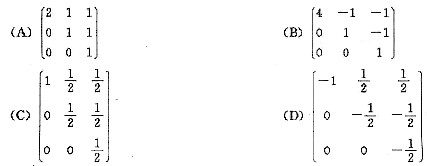问题
单项选择题
下面是测定化妆品pH的操作步骤,以下描述中,不对的是()
A.称取定量样品于50ml烧杯,加入9倍重量的水,搅拌并加热至40℃使样品与水充分混合,冷却至室温,测定样品液温度
B.按仪器要求准备pH计,并将温度补偿器调至样品液的温度
C.预计样品的pH呈碱性,分别从标准磷酸缓冲液和硼酸缓冲液的试剂瓶中倒出约10ml溶液于小烧杯中反复校正pH计
D.边搅拌边测定样品的pH,当读数稳定后,记录读数
E.全部测定完毕后,按仪器要求,冲洗电极,并将甘汞电极的橡皮塞/帽套上,玻璃电极浸泡在纯水中,缓冲液倒回瓶中
答案
参考答案:E

 ,A*是A的伴随矩阵,则(A*)-1=( )
,A*是A的伴随矩阵,则(A*)-1=( )